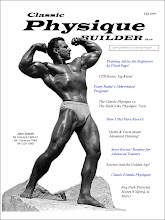 (Photo Above: Steve Reeves Working Out)
(Photo Above: Steve Reeves Working Out)How many times have you walked into the gym and seen guys plugged into iPods working out? How many times have you seen people finish listening to a song before they start their next set? Or how many times have you seen people talking while doing their reps? Is this something that you do? If so, then listen to some advice from Steve Reeves:
"If you really want to experience the greatest benefits from your training, you must enter a stage of deep concentration. Do not let your concentration be broken by anyone or anything."
Now ask yourself, if your mind is focused on the music, or if you are talking during reps, how can you be in a stage of deep concentration? If you are not using deep concentration, then how can you be getting the maximum amount of muscle stimulation from your exercise? You can't! So you are wasting your time and are probably not getting any results!
So, what can you do? When you go into the gym, be focused. Don't plug yourself into the iPod, don't do a lot of talking, don't allow yourself to get distracted. Instead, try to enter a state of deep concentration. Steve says:
"When you work out using this technique of deep concentration, concentrate on doing each movement slowly through a full range of motion. Your total concentration should be only on the muscle fibers being worked. Concentrate as much on the lowering phase (the negative) of the exercise as you would on the pressing and curling (the positive)."
Only by using deep concentration, can you mind really learn to "feel" and "know" what level of intensity results in muscle growth (this ability helps form the basis of the CPB Instinctive Training Principle - first articulated by Joe Weider). Making gains is much more than just a matter of weights, sets, and reps. It also requires a certain level of intensity - which depends on a number of factors, including your ability to use deep concentration.
To help you develop the ability to use deep concentration, Steve recommends the practice of muscle control. About this, Steve says:
"Practicing muscle control improves the lines of communication between the brain and the muscle fibers being worked. This increases the efficiency and speed of muscle development and motor skills."
In using deep concentration, you are trying to use the "lines of communication" that Steve is talking about in order to work the muscle with the intensity it needs for growth. So, how can you practice muscle control? Steve recommends the following practice:
"Muscle control can be practiced while sitting in a chair, at a desk or table. To practice controlling the muscles of the calves, hamstrings, forearms, biceps, pectorals, lats, and abdominals, do the following: Sit in a chair with your lower legs placed at a 90 degree angle to your thighs. Rest your forearms on your knees. Focus on contracting one muscle at a time. Be sure to contract each muscle and release repeatedly for one to two minutes." In Steve's book "Building the Classic Physique the Natural Way" he gives further instruction on controlling the deltoids, quads, and triceps. But you get the idea. (Steve's book can be purchased throught the Steve Reeves International Society at http://www.stevereeves.com/).
You should practice muscle control frequently. Steve suggests 10-15 minutes per day. That way, when you exercise and enter a state of deep concentration, you will really be able to focus on the muscle being worked and it will respond better because of your practice of muscle control. So these two things - muscle control and deep concentration - work together and will help you get the intensity you need for classic muscle gains!
So, put the iPod away, cut the talking, and use deep concentration and muscle control to improve the effectiveness of your workouts!
- CPB
For your free 1 year subscription to Classic Physique Builder (CPBzine), email your name, city, state (province), and country to cpbzine@gmail.com. That's it!






